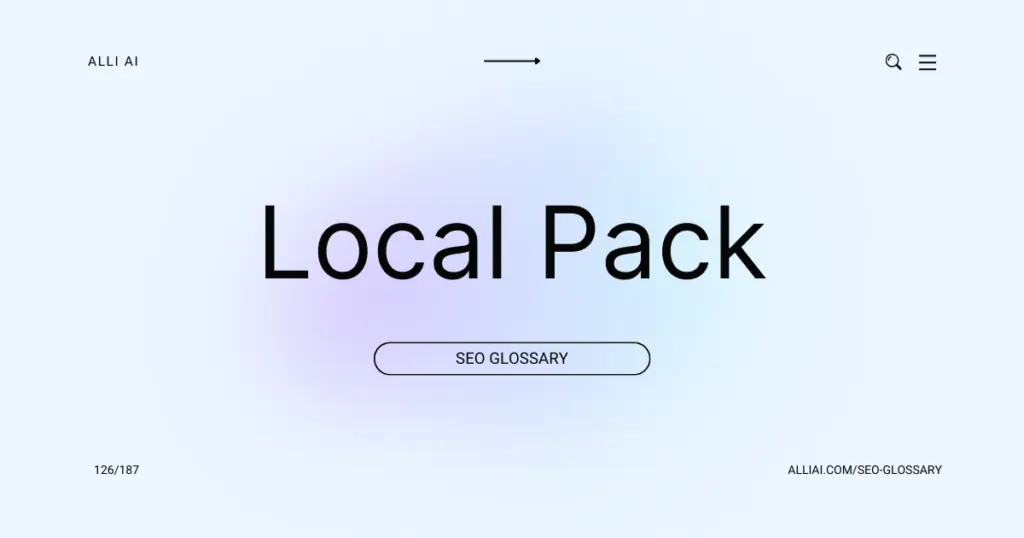What Does Local Pack Mean?
The Local Pack is a feature on Google’s search results page that shows a map and a list of businesses related to your search query. It typically displays information like the business’s name, rating, address, and phone number, helping users find local services or stores quickly.
Where Does Local Pack Fit Into The Broader SEO Landscape?
The Local Pack, part of Google’s search results, prominently displays local business listings relevant to specific queries that have local intent, such as “coffee shops near me” or “electricians in [city].” This feature is crucial for local SEO as it provides visibility directly within the main Google search results, usually appearing at the top, ensuring high visibility and potentially high click-through rates for the businesses featured in this pack. Local SEO strategies optimize a business’s chance of appearing in the Local Pack by focusing on accurate and complete Google My Business listings, accumulating positive reviews, and ensuring name, address, and phone number (NAP) consistency across online directories. Additionally, relevance and prominence, as determined by Google’s algorithm, play a significant role in determining which businesses appear in the Local Pack.
Real Life Analogies or Metaphors to Explain Local Pack
Imagine you’re at a busy outdoor market and there are three fruit stands that everyone seems to flock to. These stands are in a prime spot right at the entrance — visible, accessible, and popular. The Local Pack is like those top three fruit stands on Google search results; it highlights the top three local business listings when someone searches for services in that area. Just as those preferred stands in the market likely get the most visitors and sales, the businesses in the Local Pack get the most visibility and are more likely to be visited by local searchers.
How the Local Pack Functions or is Implemented?
1. Google My Business (GMB) Listings: Businesses must register and verify their details on Google My Business to be eligible for inclusion in the Local Pack. This includes providing accurate information such as business name, address, phone number, business hours, and category.
2. Location of the User: The geographical location of the searcher is crucial. Google uses the IP address of the searcher to determine the most relevant local businesses near them.
3. Relevance: Google looks at how well a local listing matches the search query. This includes matching keywords in the business name, description, and local posts on GMB.
4. Distance: Among relevant results, Google considers how close each business is to the location term used in a search, or to where the search is being done from if no location term is used.
5. Prominence: This involves how well-known a business is, which Google determines based on information it has about a business from across the web (like links, articles, and directories). Reviews count heavily here, with more positive ratings and detailed, positive reviews improving a business’s chances of appearing in the Local Pack.
6. Optimization of GMB Profile: Regularly updating the GMB profile with new photos, updated hours, responding to reviews, and publishing GMB posts can help improve visibility.
7. Citations and Backlinks: Listings in local online directories, and links from relevant and authoritative websites can improve the prominence and perceived relevance of a business.
8. Mobile Optimization: As a significant amount of local searches are performed on mobile devices, mobile-friendliness of the business’s website also affects Local Pack visibility.
9. User Behavior: Click-through rates, mobile clicks to call, and check-ins via Google Maps can also influence Local Pack listings as they are indicative of popularity and relevance.
10. Social Signals: Mentions on social media can enhance the visibility of local businesses in search results.
Each of these elements is weighted differently by Google’s algorithm to determine which businesses are displayed in the Local Pack for a specific local search query.
Impact Local Pack has on SEO
The Local Pack prominently features local business listings at the top of Google search result pages when users perform a local search query. This high visibility often leads to increased clicks and traffic for listed businesses, as the Local Pack usually appears before traditional organic search results. By appearing in the Local Pack, businesses gain enhanced local visibility and credibility, which can improve their SEO performance by driving more locally relevant traffic to their site. This placement also directly impacts rankings for local search terms, often giving businesses appearing in the Local Pack a competitive edge in local search markets. User experience is positively influenced as well, as the Local Pack provides quick access to essential information like business address, operating hours, and reviews, facilitating decision-making for users seeking local solutions or services.
SEO Best Practices For Local Pack
1. Claim and Verify Your Google My Business Listing: Go to Google My Business (GMB) and claim your listing. Follow all steps to verify your business, usually through a phone call or postcard mailed to your business address.
2. Optimize Your GMB Profile: Fill out every section of your GMB profile comprehensively:
– Ensure your business name, address, and phone number (NAP) are accurate and consistent with other online listings.
– Select the most relevant categories for your business.
– Write a compelling, keyword-rich business description.
– Add operational hours, including special hours for holidays.
3. Add High-Quality Photos and Videos: Regularly upload high-quality images of your business, products, or services. Include interior and exterior shots, staff working photos, and other engaging content.
4. Collect and Respond to Reviews: Encourage satisfied customers to leave positive reviews on your GMB profile. Respond professionally to all reviews, addressing any concerns raised by negative reviews.
5. Use Google Posts within Your GMB Profile: Regularly post updates, offers, events, or news to keep your profile active and engaging. This content appears directly in your GMB listing and can help attract attention in local search results.
6. Ensure NAP Consistency Across the Web: Ensure that your business’s Name, Address, and Phone Number are consistent on all online platforms and directories, like Yelp, Facebook, and industry-specific directories.
7. Optimize Your Website for Local SEO:
– Include location-based keywords in meta titles, descriptions, H1 tags, and throughout the content.
– Embed a Google Map on your contact page.
– Make sure your website is mobile-friendly, as most local searches are performed on mobile devices.
8. Build Local Backlinks: Gain backlinks from locally relevant sites such as local business groups, partners, and community blogs to strengthen your local search relevance.
9. Use Schema Markup: Implement local business Schema markup on your website to help search engines understand and display your business information in geo-targeted searches better.
10. Monitor Your Progress: Regularly check your GMB Insights to understand how users interact with your listing and where improvements can be made. Use tools like Google Analytics to monitor traffic and behavior from local search.
Common Mistakes To Avoid
1. Ignoring Google My Business Listings: Not claiming or optimizing your Google My Business listing can significantly diminish your visibility in local search results.
Solution: Claim and continually update your Google My Business profile with accurate information, including hours, location, and services.
2. Inconsistent NAP Information: Inconsistent Name, Address, and Phone Number (NAP) data across online platforms can confuse search engines and hurt rankings.
Solution: Standardize NAP information across all online platforms and directories to ensure consistency and improve local SEO.
3. Lack of Local Content: Failing to create content relevant to the local area can result in missed opportunities to appear in local searches.
Solution: Develop content that is locally relevant, such as blog posts about local events, local news, or local services to boost relevance in Local Pack listings.
4. Poor Reputation Management: Neglecting reviews, especially negative ones, can negatively affect trust and SEO performance.
Solution: Regularly monitor and respond to reviews, cautiously addressing grievances and thanking customers for positive feedback.
5. Overlooking Location-Specific Pages: Not having unique pages for different geographic locations can make it difficult for search engines to locate and index location-specific information about your business.
Solution: Create dedicated pages for each location with specific local information, including NAP details, to enhance local search engine visibility.
6. Non-Mobile-Friendly Website: Given the high volume of local searches performed on mobile devices, a non-responsive website will likely hurt local search rankings.
Solution: Ensure your website is mobile-friendly, with responsive design elements that make browsing easy on smartphones and tablets.
7. Ignoring Local Backlinks: Not acquiring local backlinks is a missed opportunity for boosting local search credibility and relevance.
Solution: Engage with local businesses and websites to generate backlinks through partnerships, local resource listings, and community events.
8. Not Using Local Business Schema: Failing to implement structured data (schema) specifically designed for local businesses means search engines might not fully understand the local context of your business.
Solution: Use Local Business Schema markup to help search engines understand and display location-based information about your business more accurately.
9. Focusing Solely on Google: While Google dominates, neglecting other search engines like Bing or Apple Maps can limit your reach.
Solution: Optimize for other search engines by updating listings on platforms like Bing Places and Apple Maps.
10. Ignoring Voice Search Optimization: As voice search becomes more prevalent, not optimizing for how people ask questions naturally can lead to missed opportunities in appearing in local searches.
Solution: Incorporate natural language processing and conversational keywords into your content and SEO strategy to cater to voice search queries.






